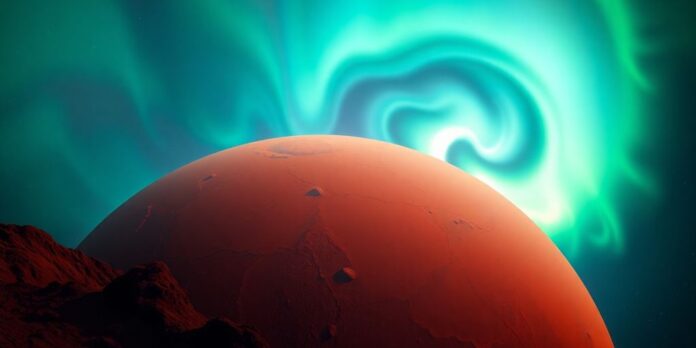On March 18, 2024, NASA’s Perseverance rover made a groundbreaking discovery by capturing the first visible-light auroras on Mars. This historic event followed a significant solar flare and coronal mass ejection from the Sun, which illuminated the Martian night sky with a stunning green glow, marking a new chapter in planetary science.
Key Takeaways
- NASA’s Perseverance rover detected visible-light auroras on Mars for the first time.
- The auroras were linked to solar energetic particles from a solar storm.
- This discovery opens new avenues for research on Martian atmospherics and space weather.
The Historic Discovery
The auroras observed by Perseverance were a result of solar energetic particles colliding with the thin Martian atmosphere. Unlike Earth, which has a global magnetic field that channels solar particles to the poles, Mars has only localized magnetic fields. This unique characteristic leads to different types of auroras, including the solar energetic particle (SEP) auroras that were first identified by the MAVEN mission in 2014.
The auroras on Mars appeared uniformly across the night sky, a stark contrast to the localized patterns typically seen on Earth. The Perseverance rover’s SuperCam spectrometer and Mastcam-Z camera were crucial in capturing this phenomenon, which emitted light at a wavelength of 557.7 nanometers, the same wavelength responsible for the green auroras on Earth.
The Role of Solar Activity
The auroras were triggered by a solar storm that occurred on March 15, 2024. This event was characterized by a coronal mass ejection, which sent a wave of charged particles toward Mars. Scientists had been monitoring solar activity closely, using models to predict when such storms might impact the Red Planet.
- Solar Flare Date: March 15, 2024
- Aurora Observation Date: March 18, 2024
- Wavelength of Emission: 557.7 nm (green light)
Coordination and Collaboration
The successful observation of the auroras was a result of meticulous planning and collaboration among various NASA teams. The Moon to Mars Space Weather Analysis Office provided real-time analysis of solar eruptions, allowing scientists to anticipate the arrival of solar storms. This coordination was essential for ensuring that the Perseverance rover was in the right position to capture the auroras during the brief window of opportunity.
Elise Knutsen, a lead researcher from the University of Oslo, expressed her excitement about the discovery, stating, "This exciting discovery opens up new possibilities for auroral research and confirms that auroras could be visible to future astronauts on Mars’ surface."
Implications for Future Exploration
The ability to observe auroras from the Martian surface not only enhances our understanding of the planet’s atmospheric dynamics but also has significant implications for future human exploration. As NASA prepares for potential manned missions to Mars, understanding the conditions that lead to auroras will be crucial for ensuring astronaut safety and mission success.
Katie Stack Morgan, acting project scientist for Perseverance, noted, "A better understanding of auroras and the conditions around Mars that lead to their formation are especially important as we prepare to send human explorers there safely."
This discovery marks a significant milestone in planetary science, providing a glimpse into the atmospheric phenomena of Mars and paving the way for future research and exploration of the Red Planet.
Sources
- NASA Observes First Visible-light Auroras at Mars, NASA Science (.gov).
- A NASA rover just showed us what an aurora looks like on Mars, The Washington Post.


